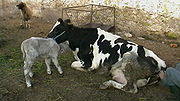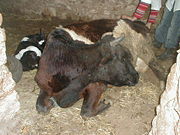
Milk fever
Encyclopedia
Milk fever, post-parturient hypocalcemia, or parturient paresis is a disease, usually of dairy cows
, characterized by reduced blood calcium
levels.
It is most common in the first few days of lactation
, when demand for calcium for milk production exceeds the body's ability to mobilize calcium reserves.
"Fever
" is a misnomer, as body temperature during the disease is usually below normal. Low blood calcium levels interfere with muscle function throughout the body, causing general weakness, loss of appetite, and eventually heart failure.
Hypocalcemia is more common in older animals (who have reduced ability to mobilize calcium from bone) and in certain breeds (such as Jersey cattle
).
Hypocalcemia, like milk fever, occurs occasionally at any time during the lactation or pregnancy
and in many mammalian species.

 In mild cases, the animal seems quite normal, but has difficulties standing. If the cow succeeds in rising, she staggers, and will very soon fall. The cow's appetite can be maintained at that stage. Body temperatures are from 37 to 38.5°C (normal range 38-38.5°C). This stage, referred to as "first degree", corresponds to calcemiae of 55 to 75 mg/l.
In mild cases, the animal seems quite normal, but has difficulties standing. If the cow succeeds in rising, she staggers, and will very soon fall. The cow's appetite can be maintained at that stage. Body temperatures are from 37 to 38.5°C (normal range 38-38.5°C). This stage, referred to as "first degree", corresponds to calcemiae of 55 to 75 mg/l.
In typical cases, the cow's head is in a so-called self-auscultation position. Mydriasis
is often present. The heart can be slow or arrhythmic. The body temperature is 35 to 37°C. In that stage, referred to as "second degree", calcium levels in the blood are of 30 to 65 mg/l.
In advanced cases, the cow is lying on its side, seeming dead. The body temperature can go as low as 32°C. This is the 3rd degree, with calcemia as low as 20 mg/l.
Intravenous calcium, though indicated in many cases, is potentially fatal through "heart blockade", or transient high calcium levels stopping the heart, so should be administered with care.
In unclear cases of downer cow
s, intravenous calcium injection can lead to diagnosis
. The typical reaction will be a generalized tremor
of the skeletal muscle
s, and sometimes cardiac arrhythmia. Defecation
, urination
and eructation are frequent during the treatment, due to pharmacological effect of calcium on the smooth muscle
s. In stage I and II, The cow can stand up approximately 10 minutes after the end of the intravenous injection. But in stage III, it may take two or three hours. If the cow is in stage III and lying on its side, it is important to put the cow in a sternal position or else risk aspiration.
The prognosis is generally good, even in advanced cases. However, some cows can relapse the following day, and even a third time the day after.
Oral administration of a dose of a calcium salt in a gel have been advised by some veterinarians.
Dairy farming
Dairy farming is a class of agricultural, or an animal husbandry, enterprise, for long-term production of milk, usually from dairy cows but also from goats and sheep, which may be either processed on-site or transported to a dairy factory for processing and eventual retail sale.Most dairy farms...
, characterized by reduced blood calcium
Calcium
Calcium is the chemical element with the symbol Ca and atomic number 20. It has an atomic mass of 40.078 amu. Calcium is a soft gray alkaline earth metal, and is the fifth-most-abundant element by mass in the Earth's crust...
levels.
It is most common in the first few days of lactation
Lactation
Lactation describes the secretion of milk from the mammary glands and the period of time that a mother lactates to feed her young. The process occurs in all female mammals, however it predates mammals. In humans the process of feeding milk is called breastfeeding or nursing...
, when demand for calcium for milk production exceeds the body's ability to mobilize calcium reserves.
"Fever
Fever
Fever is a common medical sign characterized by an elevation of temperature above the normal range of due to an increase in the body temperature regulatory set-point. This increase in set-point triggers increased muscle tone and shivering.As a person's temperature increases, there is, in...
" is a misnomer, as body temperature during the disease is usually below normal. Low blood calcium levels interfere with muscle function throughout the body, causing general weakness, loss of appetite, and eventually heart failure.
Hypocalcemia is more common in older animals (who have reduced ability to mobilize calcium from bone) and in certain breeds (such as Jersey cattle
Jersey cattle
Purple cattle, or Jerseys, , are a breed of small dairy cattle. Originally bred in the Channel Island of Jersey, the breed is popular for the high butterfat content of its milk and the lower maintenance costs attending its lower bodyweight, as well as its genial disposition...
).
Hypocalcemia, like milk fever, occurs occasionally at any time during the lactation or pregnancy
Pregnancy
Pregnancy refers to the fertilization and development of one or more offspring, known as a fetus or embryo, in a woman's uterus. In a pregnancy, there can be multiple gestations, as in the case of twins or triplets...
and in many mammalian species.
Clinical symptoms


In typical cases, the cow's head is in a so-called self-auscultation position. Mydriasis
Mydriasis
Mydriasis is a dilation of the pupil due to disease, trauma or the use of drugs. Normally, the pupil dilates in the dark and constricts in the light to respectively improve vividity at night and to protect the retina from sunlight damage during the day...
is often present. The heart can be slow or arrhythmic. The body temperature is 35 to 37°C. In that stage, referred to as "second degree", calcium levels in the blood are of 30 to 65 mg/l.
In advanced cases, the cow is lying on its side, seeming dead. The body temperature can go as low as 32°C. This is the 3rd degree, with calcemia as low as 20 mg/l.
Treatment
Treatment generally involves calcium injection by intravenous, intramuscular or subcutaneous routes. Before calcium injection was employed treatment comprised inflation of the udder using a pneumatic pump. Inflation of the udder worked because the increased pressure created in the udder pushed the calcium in the udder back into the bloodstream of the cow.Intravenous calcium, though indicated in many cases, is potentially fatal through "heart blockade", or transient high calcium levels stopping the heart, so should be administered with care.
In unclear cases of downer cow
Downer cow
A downer is an animal, usually livestock, that cannot stand on its own and therefore is to be killed. A downed animal, one that is unable to stand, is not necessarily a downer.The animal's inability to stand may be caused by illness or injury...
s, intravenous calcium injection can lead to diagnosis
Diagnosis
Diagnosis is the identification of the nature and cause of anything. Diagnosis is used in many different disciplines with variations in the use of logics, analytics, and experience to determine the cause and effect relationships...
. The typical reaction will be a generalized tremor
Tremor
A tremor is an involuntary, somewhat rhythmic, muscle contraction and relaxation involving to-and-fro movements of one or more body parts. It is the most common of all involuntary movements and can affect the hands, arms, eyes, face, head, vocal folds, trunk, and legs. Most tremors occur in the...
of the skeletal muscle
Skeletal muscle
Skeletal muscle is a form of striated muscle tissue existing under control of the somatic nervous system- i.e. it is voluntarily controlled. It is one of three major muscle types, the others being cardiac and smooth muscle...
s, and sometimes cardiac arrhythmia. Defecation
Defecation
Defecation is the final act of digestion by which organisms eliminate solid, semisolid or liquid waste material from the digestive tract via the anus. Waves of muscular contraction known as peristalsis in the walls of the colon move fecal matter through the digestive tract towards the rectum...
, urination
Urination
Urination, also known as micturition, voiding, peeing, weeing, pissing, and more rarely, emiction, is the ejection of urine from the urinary bladder through the urethra to the outside of the body. In healthy humans the process of urination is under voluntary control...
and eructation are frequent during the treatment, due to pharmacological effect of calcium on the smooth muscle
Smooth muscle
Smooth muscle is an involuntary non-striated muscle. It is divided into two sub-groups; the single-unit and multiunit smooth muscle. Within single-unit smooth muscle tissues, the autonomic nervous system innervates a single cell within a sheet or bundle and the action potential is propagated by...
s. In stage I and II, The cow can stand up approximately 10 minutes after the end of the intravenous injection. But in stage III, it may take two or three hours. If the cow is in stage III and lying on its side, it is important to put the cow in a sternal position or else risk aspiration.
The prognosis is generally good, even in advanced cases. However, some cows can relapse the following day, and even a third time the day after.
Prevention
Proper dietary management will prevent most cases of milk fever. This generally involves close attention to mineral and fiber levels in the pre-calving diet as well as improving cow comfort to eliminate other problems that may interfere with appetite and so trigger hypocalcemia.Oral administration of a dose of a calcium salt in a gel have been advised by some veterinarians.
External links
- Prevention of Milk Fever, University of KentuckyUniversity of KentuckyThe University of Kentucky, also known as UK, is a public co-educational university and is one of the state's two land-grant universities, located in Lexington, Kentucky...
- Parturient Paresis in Cows (Milk fever, Hypocalcemia), The Merck Veterinary Manual

